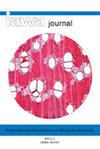Anatomical and isotopic traits in grapevine wood rings record environmental variability
IF 3.5
3区 农林科学
Q2 FORESTRY
引用次数: 0
Abstract
In the Mediterranean region, prolonged droughts affect the growth and reproductive cycles of grapevine. Changes in the physiological processes of grapevine, consequent to variations in environmental factors or cultivation management, are recorded in wood anatomical and isotopic traits in grapevine stems. In this study, we measured the anatomical traits and stable carbon isotope content in the annual rings of Vitis vinifera L. subsp. vinifera ‘Falanghina’ in four vineyards located in southern Italy, characterised by different water availability. The aim was to investigate how wood anatomical traits respond to interannual climatic variations according to local conditions. Wood cores were taken from the stem of the grapevines and subjected to both microscopy and carbon stable isotope analyses to quantify functional wood anatomical traits, such as vessel size and frequency, and the intrinsic water-use efficiency of the grapevine. Wood traits were correlated with data on precipitation and temperature. The results showed that the plants at the four vineyards were characterised by differences in wood structure influencing the grapevine’s physiology under different conditions of water availability. Overall, the analyses showed that the grapevines at the wetter sites developed wood traits, e.g., wide vessels, which favour the efficiency of water flow, while at the drier sites, they developed plant traits, e.g., small vessels, which favour safety against embolism. However, the robustness of such main trends is trait-specific and is influenced by interannual climatic variability.葡萄藤木环的解剖和同位素特征记录了环境变异
在地中海地区,长期干旱影响葡萄藤的生长和繁殖周期。由于环境因素或栽培管理的变化,葡萄藤生理过程的变化记录在葡萄藤茎的木材解剖和同位素特征中。本研究对葡萄年轮的解剖特征和稳定碳同位素含量进行了测定。Falanghina葡萄园位于意大利南部的四个葡萄园,以不同的水资源供应为特征。目的是根据当地条件调查木材解剖特征如何响应年际气候变化。从葡萄藤茎中提取木芯,并进行显微镜和碳稳定同位素分析,以量化木材的功能解剖特征,如血管大小和频率,以及葡萄藤的内在水分利用效率。木材性状与降水和温度相关。结果表明,在不同的水分条件下,四个葡萄园的植物在木材结构上的差异影响了葡萄的生理机能。总体而言,分析表明,湿润地点的葡萄藤发展出木材特征,例如,宽血管,有利于水流效率,而在干燥地点,葡萄藤发展出植物特征,例如,小血管,有利于安全防止栓塞。然而,这些主要趋势的稳健性是性状特有的,并受到年际气候变率的影响。
本文章由计算机程序翻译,如有差异,请以英文原文为准。
求助全文
约1分钟内获得全文
求助全文
来源期刊

IAWA Journal
农林科学-林学
CiteScore
3.40
自引率
15.80%
发文量
26
审稿时长
>36 weeks
期刊介绍:
The IAWA Journal is the only international periodical fully devoted to structure, function, identification and utilisation of wood and bark in trees, shrubs, lianas, palms, bamboo and herbs. Many papers are of a multidisciplinary nature, linking
 求助内容:
求助内容: 应助结果提醒方式:
应助结果提醒方式:


